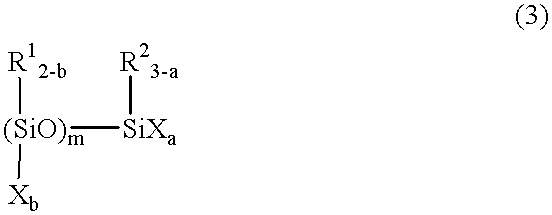Cure on demand adhesives and window module with cure on demand adhesive thereon
a technology of window modules and adhesives, applied in the field of adhesive composition, can solve the problems of large factory floor space, difficult to achieve commercialization, and difficult to achieve the effect of reducing the pressure drop resulting from driving the adhesive containing particles through the screen
- Summary
- Abstract
- Description
- Claims
- Application Information
AI Technical Summary
Benefits of technology
Problems solved by technology
Method used
Image
Examples
example 2
Preparation of a High Molecular Weight Isocyanate Prepolymer
[0129] 300.35 grams of the polyglycol of Example 1 was mixed with 600 grams of toluene and stirred at 23.degree. C. until well mixed. 8.2 milliliters of toluene diisocyanate were added and heated to 100.degree. C. with stirring. After two hours the toluene was removed with vacuum. 308 g of a clear viscous light yellow liquid were recovered. The IR spectrum of the product showed that the isocyanate peak at 2274 CM.sup.-1 was greatly reduced and the urethane peak at 1650 CM.sup.-1 increased, indicating that most of the isocyanate had reacted. The NCO concentration of this mixture was 0.69 percent measured by a wet chemical method.
example 3
Preparation of a High Molecular Weight Urethane Elastomer
[0130] 1.7 grams dibutyl tin dilaurate (Catachk 820 from Ferro Chemical Corp.) were added to 170 grams of the product of example 2. The mixture was mixed well. A 30 mil film was cast on glass plates and allowed to cure overnight at 23.degree. C. The film demonstrated good adhesion to the glass plates. The elastomer was cured in a 70% relative humidity chamber for 4 days. The average physical properties of the elastomer (5 replicates) were 301 psi tensile strength, modulus 11.44 psi, 0.64 pounds load at tear and a 934% elongation at break.
example 4
Preparation of High Molecular Weight Silyl Terminated Polyether
[0131] In a dried, heated, nitrogen purged and mechanically stirred 500 milliliter round bottom flask were added 134.94 grams of the product of Example 1, 6.33 grams of Siliquest A1310, gamma-isocyanatopropyltriethoxy-silane, and 1.52 grams dibutyl tin dilaureate. The mixture was heated to 100.degree. C. with stirring and immediately allowed to cool to room temperature. A 30 mil film was drawn on glass plates. The film was allowed to moisture cure overnight. The film was tack free in about 24 hours. The film was placed in a 70 percent humidity chamber for 5 days and then placed in an oven at 50.degree. C. overnight. The cured film had a 73 psi tensile strength, 35 psi modulus, and a 347 percent elongation at break.
PUM
| Property | Measurement | Unit |
|---|---|---|
| Percent by mass | aaaaa | aaaaa |
| Angle | aaaaa | aaaaa |
| Length | aaaaa | aaaaa |
Abstract
Description
Claims
Application Information
 Login to View More
Login to View More - R&D
- Intellectual Property
- Life Sciences
- Materials
- Tech Scout
- Unparalleled Data Quality
- Higher Quality Content
- 60% Fewer Hallucinations
Browse by: Latest US Patents, China's latest patents, Technical Efficacy Thesaurus, Application Domain, Technology Topic, Popular Technical Reports.
© 2025 PatSnap. All rights reserved.Legal|Privacy policy|Modern Slavery Act Transparency Statement|Sitemap|About US| Contact US: help@patsnap.com



